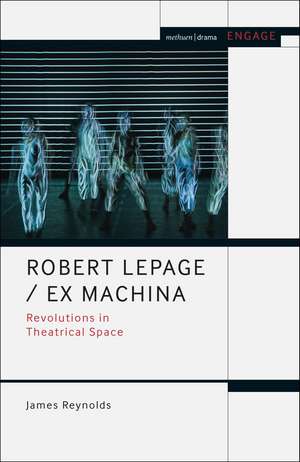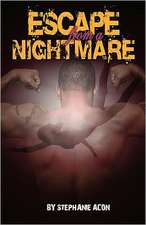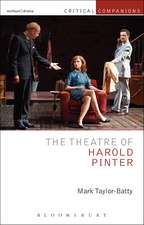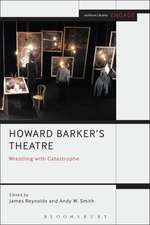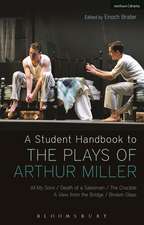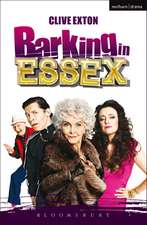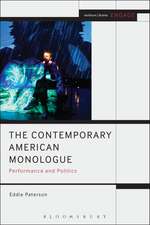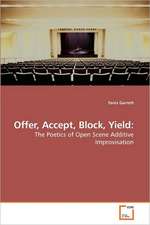Robert Lepage / Ex Machina: Revolutions in Theatrical Space: Methuen Drama Engage
Autor Dr James Reynolds Prof. Enoch Brater, Mark Taylor-Battyen Limba Engleză Hardback – 6 feb 2019
| Toate formatele și edițiile | Preț | Express |
|---|---|---|
| Paperback (1) | 216.62 lei 6-8 săpt. | |
| Bloomsbury Publishing – 27 ian 2021 | 216.62 lei 6-8 săpt. | |
| Hardback (1) | 567.17 lei 6-8 săpt. | |
| Bloomsbury Publishing – 6 feb 2019 | 567.17 lei 6-8 săpt. |
Din seria Methuen Drama Engage
- 14%
 Preț: 178.65 lei
Preț: 178.65 lei - 33%
 Preț: 134.00 lei
Preț: 134.00 lei - 30%
 Preț: 508.80 lei
Preț: 508.80 lei - 21%
 Preț: 215.79 lei
Preț: 215.79 lei - 14%
 Preț: 178.65 lei
Preț: 178.65 lei - 14%
 Preț: 178.65 lei
Preț: 178.65 lei -
 Preț: 470.80 lei
Preț: 470.80 lei -
 Preț: 446.80 lei
Preț: 446.80 lei - 14%
 Preț: 179.98 lei
Preț: 179.98 lei - 22%
 Preț: 230.86 lei
Preț: 230.86 lei -
 Preț: 190.06 lei
Preț: 190.06 lei - 30%
 Preț: 537.95 lei
Preț: 537.95 lei - 30%
 Preț: 509.30 lei
Preț: 509.30 lei -
 Preț: 233.08 lei
Preț: 233.08 lei - 22%
 Preț: 232.54 lei
Preț: 232.54 lei - 22%
 Preț: 656.47 lei
Preț: 656.47 lei - 23%
 Preț: 222.84 lei
Preț: 222.84 lei - 22%
 Preț: 231.16 lei
Preț: 231.16 lei - 30%
 Preț: 539.00 lei
Preț: 539.00 lei - 30%
 Preț: 538.09 lei
Preț: 538.09 lei - 30%
 Preț: 597.56 lei
Preț: 597.56 lei - 14%
 Preț: 178.93 lei
Preț: 178.93 lei - 30%
 Preț: 596.55 lei
Preț: 596.55 lei - 22%
 Preț: 223.85 lei
Preț: 223.85 lei - 13%
 Preț: 180.88 lei
Preț: 180.88 lei - 30%
 Preț: 566.78 lei
Preț: 566.78 lei - 13%
 Preț: 179.98 lei
Preț: 179.98 lei - 30%
 Preț: 538.26 lei
Preț: 538.26 lei - 13%
 Preț: 229.96 lei
Preț: 229.96 lei - 30%
 Preț: 539.42 lei
Preț: 539.42 lei - 23%
 Preț: 223.10 lei
Preț: 223.10 lei - 30%
 Preț: 568.06 lei
Preț: 568.06 lei - 22%
 Preț: 834.28 lei
Preț: 834.28 lei -
 Preț: 172.74 lei
Preț: 172.74 lei - 22%
 Preț: 655.50 lei
Preț: 655.50 lei
Preț: 567.17 lei
Preț vechi: 814.99 lei
-30% Nou
Puncte Express: 851
Preț estimativ în valută:
108.54€ • 112.63$ • 90.72£
108.54€ • 112.63$ • 90.72£
Carte tipărită la comandă
Livrare economică 18 martie-01 aprilie
Preluare comenzi: 021 569.72.76
Specificații
ISBN-13: 9781474276092
ISBN-10: 1474276091
Pagini: 256
Ilustrații: 12 bw illus
Dimensiuni: 138 x 216 mm
Greutate: 0.41 kg
Editura: Bloomsbury Publishing
Colecția Methuen Drama
Seria Methuen Drama Engage
Locul publicării:London, United Kingdom
ISBN-10: 1474276091
Pagini: 256
Ilustrații: 12 bw illus
Dimensiuni: 138 x 216 mm
Greutate: 0.41 kg
Editura: Bloomsbury Publishing
Colecția Methuen Drama
Seria Methuen Drama Engage
Locul publicării:London, United Kingdom
Caracteristici
Ideally suited to courses on devising theatre and those examining the practice and process of key practitioners - these courses are ubiquitous in the UK, and appear in the US and Canada
Notă biografică
Dr James Reynolds is a Senior Lecturer in Drama at Kingston University, London, UK. His Ph.D. research at Queen Mary, University of London investigated performance practices in Robert Lepage's devised theatre. His publications include Howard Barker's Theatre: Wrestling with Catastrophe (Bloomsbury Methuen Drama, 2015) co-edited with Andy W. Smith, and Addiction and Performance (2014), co-edited with Zoe Zontou.
Cuprins
AcknowledgementsIntroduction: GenesisEx Machina in briefRevolutions in theatrical spaceArchitectural aestheticsThe road to Ex MachinaLearning curvesFoundations: la Caserne and the patenteuxPart One: Foundations and Stepping Stones (1994-1999)IntroductionChapter One: Lepagean AestheticsDiscovering Japan's geo-poetry: Seven Streams of the River Ota Turning the power of space into theatreContradiction as aesthetic keyFlagshipsCounterpoint: A Dream Play Chapter Two: Making Concrete NarrativesGround work: The Geometry of Miracles Concrete poetry Making Narrative Concrete: Elsinore Scenographic acting and the body politicConcrete narratives - sublime effectsCritical condition Form as cultural expression Chapter Three: Critical ThemesEvolution Turning point: the importance of CelestineClass, contradiction and the antiheroThe Damnation of Faust in JapanProcess, collaboration, authorship and directingCultural difference, cultural specificityPart Two: Choosing All Directions (2000-2008)IntroductionChapter Four: UpgradesZulu Time: Q for QuébecUpgrading the TrilogyThe importance of MétissagesMaking The Far Side of the MoonDramatic devices and the architecture of convergence Chapter Five: Québec Stories Art and politics: La Casa Azul and The Busker's OperaDance with three hands: EonnagataNarrative terms: the story of the story of the storytellerKÀ: entertainment architecture Writing the myth Reading the circus Chapter Six: New Ways The Image Mill: all roads lead to homeOpera on tour: 1984 and The Rake's ProgressEx Machina at the Metropolitan Opera The Blue Dragon: character, culture and concrete narrativeLipsynch: staging the screamProcess in process Part Three: Starting Points (2008-2018)IntroductionChapter Seven: Critical RelationshipsThe Nightingale and Other Short FablesTotem: evolving through the gift shopCollaboration: Ex Machina and the Metropolitan Opera Wagner, architectural aesthetics, and Der Ring des NibelungenReviewing the RingThe Tempest and L'Amour de LoinPaying for art Chapter Eight: Brave New WorldsVirtual reality: The Library at NightThe Tempest: collaborating the nationHearts design Writing HeartsConcrete HeartsWritingBet on red Chapter Nine: BeginningFrame by FrameUpgrades Making 887Taking the narrative turnLe DiamantCoda NotesBibliographyIndex
Recenzii
The 'revolutions' in the title of this exhaustively researched study refer at first glance to the immenseimpact Robert Lepage has had on international theatre culture through the works he has produced withthe team of designers, scenographers, architects, project managers, dramaturgs, performers, and technicianshe has assembled in his Quebec City-based company, Ex Machina . Reynolds's personal observations of Lepage in rehearsal are detailed and revelatory.
Robert Lepage is one of theatre's greatest living artists. This book shows why. Engaging comprehensively and intimately with Lepage's huge range of work, it reveals his extraordinary theatrical inventiveness and deep political commitment.
In this provocative volume James Reynolds offers new ways of understanding Robert Lepage's approach to theatre-making, arguing persuasively that this approach must be understood in spatial and architectural terms. Making skillful use of interview material and behind-the-scenes access to several Ex Machina productions and co-productions, this book offers Lepage studies a much-needed kick in the pants.
Robert Lepage is one of theatre's greatest living artists. This book shows why. Engaging comprehensively and intimately with Lepage's huge range of work, it reveals his extraordinary theatrical inventiveness and deep political commitment.
In this provocative volume James Reynolds offers new ways of understanding Robert Lepage's approach to theatre-making, arguing persuasively that this approach must be understood in spatial and architectural terms. Making skillful use of interview material and behind-the-scenes access to several Ex Machina productions and co-productions, this book offers Lepage studies a much-needed kick in the pants.
